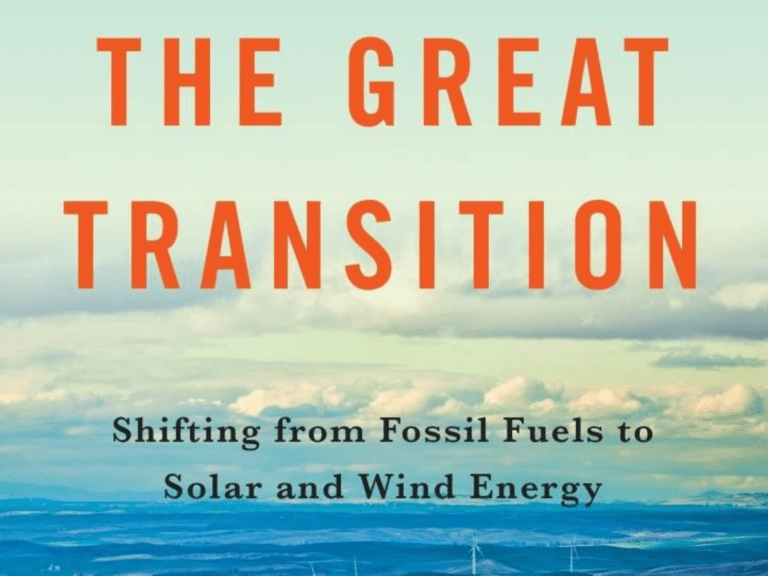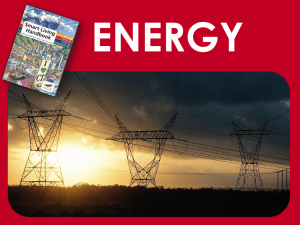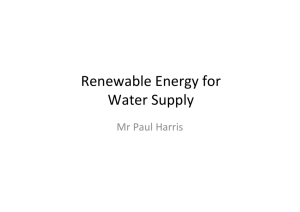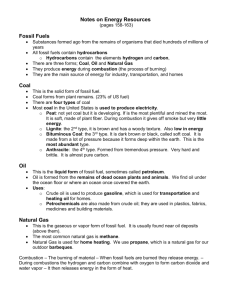Title Slide - Earth Policy Institute
advertisement

Press Conference April 16, 2015 for The Great Transition: Shifting from Fossil Fuels to Solar and Wind Energy With Co-authors Lester R. Brown, Janet Larsen, and J. Matthew Roney Global Annual Energy Growth since 2008 70 Source: EPI from BP, EIA, and REN21 Percent 50 40 30 20 10 0 Earth Policy Institute - www.earth-policy.org 60 More Wind on the Grid • Portugal and Spain, wind generation > coal • On some days wind power exceeds half of Ireland’s electricity generation • Four German states get more than 50% of their electricity from wind Wind Share of Electricity Generation in Leading Countries, 2014 Denmark 42,8 Portugal 24,1 Spain 20,0 Ireland 18,9 United Kingdom 9,4 Germany 9,1 Romania 8,8 0 10 Source: Compiled by EPI from Energinet.dk; REN; REE; EirGrid; DECC; BDEW; Transelectrica 20 30 Percent 40 Earth Policy Institute - www.earth-policy.org • European countries dominate in the share of electricity generated from wind farms 50 Low-Carbon, Low-Risk Energy Photo Credit: Wikimedia Commons/ILIOTEC Solar GmbH; Iberdrola Renewables Inc.; Gretar Ívarsson Billionaires Betting Big on Renewables • Warren Buffett – $15 billion invested in solar and wind by early 2014 – “There’s another $15 billion ready to go.” • Ted Turner – With utility Southern Power, acquired 7 solar PV farms totaling ~300 MW • Philip Anschutz – Will soon have a massive 3,000 MW wind farm under construction in Wyoming to supply CA, NV, AZ Photo Credit: Todd Spink THE SOLAR REVOLUTION Photo Credit: Dennis Schroeder / NREL The Solar Revolution • Solar PV growing > 50% annually Levelized Cost of Energy for Utility-scale Solar PV Systems in the United States, 2009-2014 • Globally, solar panels > $74/W in 1972 • In 2014, < $0.70/W • Installed cost of PV down 50% since 2011 Image Credit: Lazard Solar Beating the Grid Cumulative Installed Solar Photovoltaics Capacity in Leading Countries, 2000-2014 • In growing number of markets, solar electricity now cheaper than grid avg 40 000 Germany 35 000 • U.S. ramping up • Staggering goals in China and India – 100 GW each • Rural electrification • Policy giving way to economics Megawatts – Solarization of U.S. home sector 30 000 China 25 000 Japan 20 000 Italy 15 000 U.S. 10 000 5 000 0 2000 2005 2010 Source: EPI from BP, IEA-PVPS 2015 Earth Policy Institute - www.earth-policy.org 45 000 THE AGE OF WIND Photo Credit: Wikimedia Commons/Drenaline The Age of Wind World Cumulative Installed Wind Power Capacity, 1980-2014 • Generation growing > 20% per year 400 000 Earth Policy Institute - www.earth-policy.org 350 000 300 000 Megawatts 250 000 200 000 150 000 100 000 50 000 0 1980 1990 2000 2010 Source: EPI from GWEC, Worldwatch 2020 • 370 GW worldwide – Enough for 90m U.S. homes • Development heating up in Latin America • Asia overtook Europe in 2014 World Wind Leaderboard • Denmark: wind will be cheapest electricity source by 2016, half cost of new coal or gas 120 000 China 105 000 90 000 75 000 United States 60 000 45 000 Germany 30 000 Spain India United Kingdom 15 000 0 1980 1985 1990 1995 2000 2005 2010 2015 Earth Policy Institute - www.earth-policy.org • U.K. and Germany: wind up, coal down 135 000 Megawatts • China added 23 GW in 2014 Cumulative Installed Wind Power Capacity in Leading Countries, 1995-2014 2020 Source: EPI from GWEC, Worldwatch, CREIA, EWEA, BWEA U.S. Wind Power 120 000 110 000 100 000 90 000 Megawatts 80 000 70 000 60 000 50 000 40 000 30 000 20 000 10 000 0 Source: EPI from GWEC, AWEA Earth Policy Institute - www.earth-policy.org 130 000 Cumulative Installed Wind Power Capacity in Leading Countries and Texas, 2014 • China has greater installed wind capacity, but U.S. wind farms generate more electricity • Cost of U.S. wind power down ~60% since 2009 • Nine states generate >12% of electricity from wind • Texas 9% wind, > nuclear Wind Overtakes Nuclear in China • Wind is now China’s #3 electricity source behind coal and hydro Wind- and Nuclear-generated Electricity in China, 1995-2014 180 Wind 140 • Wind potential could meet 10x demand • Wind could meet power needs of most of top 10 carbon emitters 120 Terawatt-hours • Goal = 200 GW of wind capacity by 2020 Nuclear 100 80 60 40 20 0 1995 2000 2005 2010 Source: EPI from BP, NEA, CNEA 2015 Earth Policy Institute - www.earth-policy.org 160 NUCLEAR POWER IN DECLINE Photo Credit: Sandia Science & Technology Park Nuclear Power in Decline World Electricity Generation from Nuclear Power Plants, 1970-2014 Earth Policy Institute - www.earth-policy.org 3 000 2 500 2 000 Terawatt-hours • Global nuclear generation peaked in 2006 • Peaked in France in 2005; United States in 2010 • Number of operating reactors dropped from high of 438 in 2002 to 390 as of end-2014 1 500 1 000 500 0 1970 1980 1990 2000 2010 Source: EPI from BP, IAEA/Chabot 2020 Costly from Cradle… • Unlike with wind and solar power, building new nuclear facilities has become more expensive over time • Construction delays and cost overruns are typical features of nuclear projects • Of 66 reactors under construction in mid-2014, 49 were behind schedule, including all 5 in the United States and 20 of 27 in China Photo Credit: Wikimedia Commons/ Tennessee Valley Authority …to Grave • Costs rising for aging plants— operation, maintenance, fuel • Five U.S. reactors have retired early since 2013 • Closing is costly: ~$4.4 billion for two California reactors; $130 billion for 4-reactor U.K. site with legacy of weapons-grade plutonium • Waste issue remains unresolved • Accident risk Photo credit: Wikimedia Commons/awnisALAN TA P P I N G T H E E A R T H ’ S H E AT Photo credit: Wikimedia Commons/Gretar Ívarsson Geothermal Power Geothermal Share of Electricity Generation in Leading Countries, 2012 Earth Policy Institute - www.earth-policy.org Iceland El Salvador Kenya Philippines New Zealand Costa Rica Nicaragua Papua New Guinea Source: EPI from EIA Indonesia 0 10 20 Percent 30 40 • Japan has enough geothermal power potential to meet over half its electricity needs • Could power some 40 countries’ economies • Philippines’ goal is 3,300 MW by 2030 • Indonesia’s target is 10,000 MW by 2025 • EGS technology could lead to some 500,000 MW of geothermal power in the United States HYDROPOWER: PA S T A N D F U T U R E Photo credit: Farwestern / Gregg M. Erickson via Wikimedia Commons Hydropower Worldwide World Hydroelectric Generation, 1965-2013 Earth Policy Institute - www.earth-policy.org 4 000 3 500 Terawatt-hours 3 000 2 500 2 000 1 500 1 000 500 0 1965 1975 1985 1995 Source: BP, IEA 2005 2015 • Used in 150 countries • Supplies 16% of the world’s electricity • Global capacity of 1 million MW • Of the world’s 45,000 large dams, 8,600 generate electricity • Pumped storage CLOSING COAL PLANTS Photo Credit: National Renewable Energy Laboratory Peak Coal in China? • China’s coal use: Coal Consumption in China, 1965-2014 Earth Policy Institute - www.earth-policy.org 2 000 Million Tons Oil Equivalent 1 800 1 600 1 400 1 200 1 000 800 600 400 200 0 1965 1975 1985 1995 Source: BP; NBS 2005 2015 – Exceeds the rest of the world combined – But fell in 2014 for the first time in recent history • Peak coal is near: – – – – – – Air pollution concerns Environmental regulations Wind and solar booming Improving efficiency Slowing economic growth U.S.-China climate agreement India Coal Use Growing Coal Consumption in India, 1965-2013 Earth Policy Institute - www.earth-policy.org 350 Million Tons Oil Equivalent 300 250 200 150 100 50 0 1965 1975 1985 1995 Source: BP 2005 2015 • Indian government claims to be doubling down on coal, planning hundreds of new plants • How many will be built remains to be seen – Urban air pollution worse than in China – Local opposition to coal – Taxes on coal doubled, partly funding solar development – Solar costs undercut the grid in most of the country Coal Plants Closing Coal Consumption in the United States, 1965-2014 Earth Policy Institute - www.earth-policy.org 700 Million Tons Oil Equivalent 600 500 400 300 200 100 0 1965 1975 1985 1995 Source: EIA 2005 2015 • Lower natural gas prices, air pollution regulations, and local campaigns are closing coal plants across the United States • Of the 523 U.S. coal-fired power plants, 188 have recently closed or plan to close • Australia, Canada, and many E.U. countries have also passed peak coal T H E R I S E A N D FA L L OF OIL Photo Credit: U.S. Coast Guard U.S. Oil Use Down U.S. Oil Consumption and Production, 1965-2014 Million Barrels Per Day 20 Consumption 15 10 Production 5 0 1965 1975 1985 1995 Source: EPI from EIA 2005 Earth Policy Institute - www.earth-policy.org 25 2015 • U.S. #1 consumer • U.S. oil use fell 8.5% from 2005 to 2014 – – – – People driving less Better vehicle efficiency Public transit expanding Culture change: young people no longer prioritizing cars – Car sharing and bike sharing spreading A C C E L E R AT I N G T H E TRANSITION Photo Credit: iStockPhoto / Joe Gough Carbon Pricing in Action Image Credit: World Bank Renewables Make Business Sense • Large investment banks channeling tens of billions into renewables • > 600 U.S. institutions at 100% green power • Walmart aiming for 660 PV systems on U.S. buildings by 2018 • Apple’s 25-year, $850 million solar power purchase agreement with First Solar to supply CA operations • Google’s 100% renewable electricity goal: wind; abandoned CA oil and gas field 82-MW solar farm Photo Credit: Walmart/Flickr; SunEdison To learn more about the energy transition… read The Great Transition: Shifting from Fossil Fuels to Solar and Wind Energy by Lester R. Brown with Janet Larsen, J. Matthew Roney, and Emily E. Adams. The book and supporting data are available at www.earth-policy.org #GreatTransition Our Clean Energy Future The energy transition will change not only how we view the world but also how we view ourselves. Coal plant smokestacks that dirty the air and alter the climate will be replaced by solar panels on our rooftops and wind turbines turning gracefully in the distance. Welcome to the clean energy era. – Chapter 9, The Great Transition








